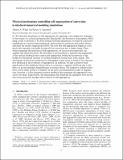| dc.contributor.author | Wing, Allison A. | |
| dc.contributor.author | Emanuel, Kerry Andrew | |
| dc.date.accessioned | 2015-07-31T17:20:11Z | |
| dc.date.available | 2015-07-31T17:20:11Z | |
| dc.date.issued | 2014-02 | |
| dc.date.submitted | 2013-09 | |
| dc.identifier.issn | 19422466 | |
| dc.identifier.uri | http://hdl.handle.net/1721.1/97935 | |
| dc.description.abstract | We elucidate the physics of self-aggregation by applying a new diagnostic technique to the output of a cloud resolving model. Specifically, the System for Atmospheric Modeling is used to perform 3- D cloud system resolving simulations of radiative-convective equilibrium in a nonrotating framework, with interactive radiation and surface fluxes and fixed sea surface temperature (SST). We note that self-aggregation begins as a dry patch that expands, eventually forcing all the convection into a single clump. Thus, when examining the initiation of self-aggregation, we focus on processes that can amplify this initial dry patch. We introduce a novel method to quantify the magnitudes of the various feedbacks that control self-aggregation within the framework of the budget for the spatial variance of column-integrated frozen moist static energy. The absorption of shortwave radiation by atmospheric water vapor is found to be a key positive feedback in the evolution of aggregation. In addition, we find a positive wind speed-surface flux feedback whose role is to counteract a negative feedback due to the effect of air-sea enthalpy disequilibrium on surface fluxes. The longwave radiation feedback can be either positive or negative in the early and intermediate stages of aggregation; however, it is the dominant positive feedback that maintains the aggregated state once it develops. Importantly, the mechanisms that maintain the aggregate state are distinct from those that instigate the evolution of self-aggregation. | en_US |
| dc.description.sponsorship | National Science Foundation (U.S.) (Grant 1032244) | en_US |
| dc.description.sponsorship | National Science Foundation (U.S.) (Grant 1136480) | en_US |
| dc.description.sponsorship | National Science Foundation (U.S.) (Grant 0850639) | en_US |
| dc.description.sponsorship | Massachusetts Institute of Technology. Joint Program on the Science & Policy of Global Change | en_US |
| dc.language.iso | en_US | |
| dc.publisher | American Geophysical Union (AGU) | en_US |
| dc.relation.isversionof | http://dx.doi.org/10.1002/2013ms000269 | en_US |
| dc.rights | Article is made available in accordance with the publisher's policy and may be subject to US copyright law. Please refer to the publisher's site for terms of use. | en_US |
| dc.source | MIT web domain | en_US |
| dc.title | Physical mechanisms controlling self-aggregation of convection in idealized numerical modeling simulations | en_US |
| dc.type | Article | en_US |
| dc.identifier.citation | Wing, Allison A., and Kerry A. Emanuel. “Physical Mechanisms Controlling Self-Aggregation of Convection in Idealized Numerical Modeling Simulations.” Journal of Advances in Modeling Earth Systems 6, no. 1 (February 5, 2014): 59–74. © 2014 American Geophysical Union | en_US |
| dc.contributor.department | Massachusetts Institute of Technology. Department of Earth, Atmospheric, and Planetary Sciences | en_US |
| dc.contributor.department | Massachusetts Institute of Technology. Program in Atmospheres, Oceans, and Climate | en_US |
| dc.contributor.department | Woods Hole Oceanographic Institution | en_US |
| dc.contributor.mitauthor | Wing, Allison A. | en_US |
| dc.contributor.mitauthor | Emanuel, Kerry Andrew | en_US |
| dc.relation.journal | Journal of Advances in Modeling Earth Systems | en_US |
| dc.eprint.version | Final published version | en_US |
| dc.type.uri | http://purl.org/eprint/type/JournalArticle | en_US |
| eprint.status | http://purl.org/eprint/status/PeerReviewed | en_US |
| dspace.orderedauthors | Wing, Allison A.; Emanuel, Kerry A. | en_US |
| dc.identifier.orcid | https://orcid.org/0000-0003-2194-8709 | |
| dc.identifier.orcid | https://orcid.org/0000-0002-2066-2082 | |
| mit.license | PUBLISHER_POLICY | en_US |
| mit.metadata.status | Complete | |
